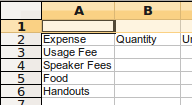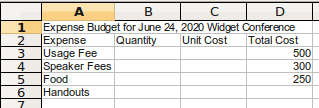Entering data in cells
| Working with Spreadsheets in OpenOffice.org Calc | |
|---|---|
| Working with cells | Selection | Inserting | Deleting | Widths and heights | Entering data | Changing contents | Copy, move, delete | Shifting cells | Sorting data | Speeding data entry | Find and replace | Practice | Summary |
Sometimes the best learning comes from just doing something and thinking about it later. To that end, we've encouraged you to enter data in spreadsheet cells as you learned about other functionality (inserting, deleting,...). And with any luck, you've been successful. So now that you've experienced 'data entry', let's explore the content or data that can be entered into cells.
How Calc treats different types of data
Data entered into cells may be of three types - numeric, text or date.
Numeric data
If a set of pure digits, that is any combination of 0,1,2,3,4,5,6,7,8, or 9, are typed in a cell, Calc treats the data as numeric; arithmetic operations may therefore be carried out on such data. The default alignment for numeric data is right justified, such that numbers in columns are decimal-aligned.
If a single apostrophe is typed in front of a set of digits (e.g., '1234), Calc will treat the numbers as ordinary text. Numbers specified as text values cannot be used to perform arithmetic operations.
Text data
When you want to enter text in a cell click on the cell in which you want to enter the text and type. The default alignment for text data is left justified.
As you saw in the previous activity, text will flow over from one cell to the next as long as the subsequent cells are empty. But note that the cell in which you started typing actually contains all of the text (no matter how many cells the text covers).
Did you notice?
You can revise data entered in a cell, in two ways:
- Double click in the cell that contains the data.
- Select the cell and click once in the Input line.
A blinking upright line cursor, | , displays indicating you are in data edit mode.
Date data
If you enter numbers in a format that Calc recognises as a date, Calc will treat the entry as a date and reformat the contents of the cell into the default date format. Interestingly, what Calc interprets as a date and the format to which Calc converts it, depends on the locale settings of your operating system. For example, in Canada, 20 Sep 2008, 20 September 2008, 20.09.08, and 20-09-2008 will all be interpreted by Calc as dates and Calc will reformat these as 20/09/08 in all cases.
If you wish these not to be interpreted as dates, precede the entry with a single apostrophe and the data will be interpreted as text.
When the entry in a cell is interpreted as a date, certain types of date arithmetic can be performed. For example, two dates can be subtracted to yield the number of days between them. If a number is added to a date, this is interpreted as a number of days and the result will be another date.
Let's add a due date to our Expense spreadsheet.
Hopefully, your system interprets your entry as a date. If not, try a different format. |
Tips & tricks for entering data
- You may have noticed that when you press Enter after you have completed your data entry, the cell below is selected.
- To move to the right, press Tab instead of Enter.
- You may also use the direction arrows to move to an adjacent cell.
- You can change the default setting for what cell Calc selects next when Enter is pressed.
- Select Tools > Options.
- In the left side bar, expand the OpenOffice.org Calc heading, by clicking on the + sign.
- Select General, in the sub-listing.
- In the Input Settings option, note that Press Enter to move selections is checked.
- Choose a direction in the drop down box on the right: Down, Right, Up, or Left, .
- Click OK.



